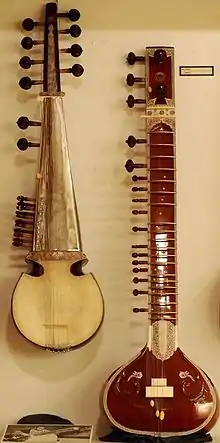Surbahar
Surbahar (pronunciation:[s̪urbəhɑːr] सुरबहार) (literally: "Springtime of Notes"),[1] sometimes known as bass sitar, is a plucked string instrument used in the Hindustani classical music of the Indian subcontinent. It is closely related to the sitar, but has a lower tone. Depending on the instrument's size, it is usually pitched two to five whole steps below the standard sitar.
 | |
| Classification |
|
|---|---|
| Related instruments | |
Overview
The surbahar is over 130 cm (51 inches). It uses a dried gourd as a resonator, and has a neck with very wide frets, which allow a glissando of six notes on the same fret through the method of pulling. The neck is made out of toona, or teak wood. It has 3-4 rhythm strings (chikari), four playing strings (the broadest 1 mm), and 10 to 11 sympathetic strings. There are two bridges; the playable strings pass over the greater bridge, which is connected to the tabli with small legs, which are glued in place. The sympathetic strings pass over the smaller bridge which is directly glued on the tabli. The bridges have a slightly curved upper surface parallel to the string that the strings touch when vibrating, which results in a buzzing sound known as jawari. The instrumentalist plays the strings using a metallic plectrum, the mizrab, which is fixed on the index finger of the player's right hand. Three plectrums are used to play the dhrupad style of alap, jor, and jhala on surbahar. In the dhrupad style, instead of performing the sitarkhani and masitkhani gats, the instrumentalist plays the slow dhrupad composition in accompaniment with pakhawaj.
Some researchers believe that surbahar was invented around 1825. Surbahar was invented by Omrao Khan Beenkar and Ghulam Mohammad was his disciple. Omrao Khan Beenkar was the grandfather of Wazir Khan of Rampur. The invention is also attributed to Ustad Sahebdad Khan. Recent research shows that Lucknow-based sitarist Ustad Ghulam Mohammed may also have been the inventor.[2] A similar kind of instrument , known as the Mahakachhapi Vina, is also known to exist during that period.[3]
Notable performers
- Umrao Khan
- Sajjad Mohammad Khan
- Annapurna Devi (1927 - 2018)
- Balaram Pathak (1926 - 1991)
- Imdad Khan (1848 - 1920)
- Wahid Khan
- Enayat Khan (1894 - 1938)
- Imrat Khan (1935 - 2018)
- Mushtaq Ali Khan (1911 - 1989)
- Pushparaj Koshti (born 1950) [4]
- Irshad Khan
- Budhaditya Mukherjee (born 1955)
- Manilal Nag (born 1939)
- Kushal Das (born 1959)
- Rajeev Janardan (born 1967)
- Suvir Misra
- Deobrat Mishra (born 1976)
- Santosh Banerjee
- Jaya Biswas
- Babu Khan
- Nilofer Khan
- Surendranath Bandyopadhyay
- Ramprasanna Bandyopadhyay (1871 - 1929)
- Jagdeep Singh Bedi
- Rameshwar Pathak (1938 - 2010)
- Ram Govind Pathak
- Ashok Pathak (born 1949) [5]
- Sri Bhakti Prabhu
References
